Exhibition stand construction / Design: The message in 3D
Not every product reveals its benefits to the customer when exhibited or demonstrated. In cases like these, exhibition stand planners create themed worlds revolving around the brand or end product.
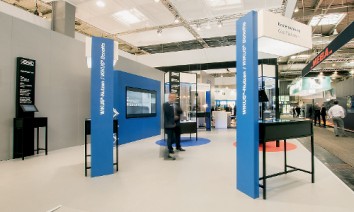
Wikus, a company based in Spangenburg, places the focus on high-precision cutting in its marketing communications. Wikus is Europe’s largest band saw manufacturer and a global market leader in metal saws. The exhibition stand planners at Unicblue in Gelsenkirchen incorporated this focus on high-precision cutting in their modular stand design. The stand was built for the first time for EMO 2017, the leading world fair for metal processing, which took place in Hanover. “The stand looked like a workpiece that had been in cut in two by a Wikus band saw,” explains Christian Poell, head of sales at Unicblue. The cut was represented by a narrow central area with black flooring and a black rear wall. It divided the stand into two sections with a spacious exhibition area on the left and a generous space on the right for communication and catering. On the left, in the product area, discreet shades of grey dominated on the walls and floor, with cold white lighting.
The product tables, in black and blue, stood out clearly against this background. The latest saw blades were displayed behind glass and could also be taken out of drawers and handled. The catering and communication area on the right, on the other hand, had warm colours and lighting. Oak-effect laminate flooring contributed to the inviting atmosphere. “We deliberately set the tone through the lighting and flooring of the two different spaces,” says creative director Daniel Filipe. The narrow dividing passage in the middle put the message across in a different way: with three desks at which visitors could get quick advice. This part of the stand was thus the interface between the products and the communication space, where contact with customers was established (www.unicblue.com).
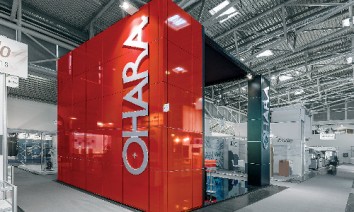
Raw glass doesn’t really make much of an exhibit on its own. This is where the creativity of exhibition stand developers comes in: how can optical glass be presented in an attractive, captivating way? The Japanese company Ohara is a leading manufacturer of raw glass for products such as lenses or mirrors. The company generally comes to trade fairs without exhibits – yet still manages to captivate those who visit its stand. The Wiesbaden-based exhibition stand construction company Isinger and Merz has been designing impressive stands for its customers for 12 years. One new design made its debut at Laser – World of Photonics 2017 in Munich. The designer Dieter Kirchhoff came up with a stand that really caught the eye. Its colourful walls and columns stood out from some distance away. A cross-media agency created a spectacular 3D show to go with it, which showed how the glass is produced and finished. “Visitors were really impressed by the 48 square metre stand,” recalls Jens Gliedstein, marketing director at Isinger and Merz. “It stood out like an exclamation mark.”
There is another factor of great importance to the exhibitor: sustainability. Ohara was the first manufacturer to switch to environmentally friendly glass and adhere rigorously to it. In order to minimise the impact on the environment of its trade fair appearances as well, Ohara uses the modular Isidesign system from Isinger and Merz, which is long-lasting, recyclable, robust, has an attractive finish and can be put together very quickly. When it comes to sustainability, the exhibitor and exhibition stand construction company are on the same wavelength. In 2017 Isinger and Merz was certified as a sustainable company by the trade fair association FAMAB. The certification goes far beyond building resource-efficient exhibition stands. The company’s social responsibility – towards customers, partner companies and its staff – were also rated as exemplary (www.isinger-merz.de).
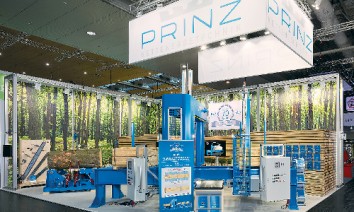
Chainsaws turn tree trunks into building material. The idea of the exhibitor, Prinz, and the exhibition stand construction company, MDS Messebau, was a simple one: instead of exhibiting the company’s timber processing machinery, they would shift the focus to the initial material and the end product. Prinz, which is based in Loosdorf, Austria, is a leading manufacturer of sawing machines, technology and accessories. At the industry trade fair Ligna 2017 in Hanover, it surrounded its latest machines and tools with wood, showing how it looks before and after sawing. Printed fabrics with forest motifs encased the stand as walls on two sides. On one of the machines, part of a tree trunk lay ready to be sawed. Walls that gave the impression of stacked planks separated the storage area, kitchen and lounge from the exhibition space. The lounge was adorned with furniture made from Euro pallets with dark brown upholstery and glass table tops, and wood flooring completed the picture.
“Not only did our stand design establish a link from the forest to timber processing and then to the final product,” explains Vanessa Niemann, marketing director at MDS Messebau, which is based in Buchholz in der Nordheide. “It also rose above what is a rather sober, technical context with its pleasant, comfortable ambience based on the use of wood and forest motifs.” The stand also resulted in material advantages in the truest sense of the word: it didn’t require much time or many people to erect it, and there were few construction elements involved. Essentially, it combined construction system elements with large graphics. Its timber-themed appearance and the wood and pallets used as decorative furniture lent it a completely individual touch (www.mdsmessebau.de).
Author: Jens Kügler
This article was published in TFI issue 3/2017
Share in Facebook, Twitter or Google+:
TFI - Trade Fairs International - The International Trade Fair Magazine.
© 2006 - 2024 by TFI-Verlagsgesellschaft mbH. All rights reserved. TFI-Verlagsgesellschaft mbH shall accept no responsibility for the contents of external links and other contents.
TFI-Know-how
-
What to do when things go wrong at virtual or in-person events?

In the event world, it’s simply part of life if things don’t work out as planned.
-
How can networking be made to work at online events?

Networking typically happens at real, in-person events. But it’s also possible to do it online; it just works a little differently. There are various options available to organisers.
-
How can exhibitors stand out at trade fairs?
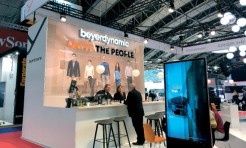
New products and a well-conceived stand design are not the only drivers for a successful presence. Many other factors are also important, but trade fair planners often lose sight of them.
-
How can industry decision-makers be reached online?
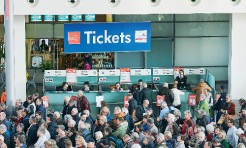
Trade fairs and trade fair companies need to constantly further develop, become more agile and flexible and offer services all year round. New, digital offerings are very important here. With its TrustedTargeting technology, Messe München offers its customers access to leading business-to-business decision-makers on the Internet.


